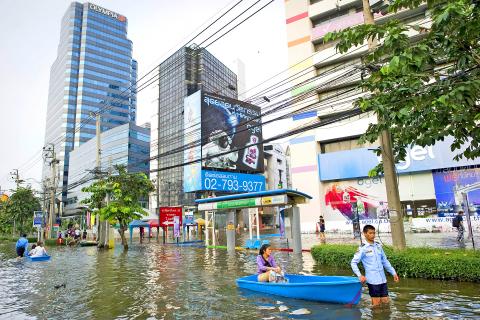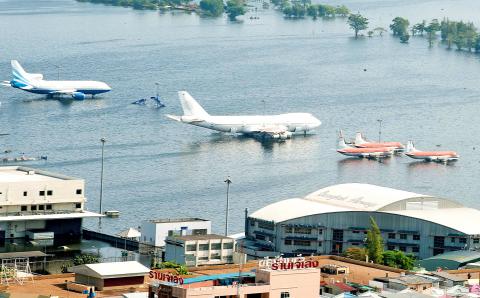As Bangkok hosted climate-change talks yesterday, the sprawling city of more than 10 million is itself under siege from the environment, with dire forecasts warning it could be partially submerged in just over a decade.
A preparatory meeting begins Tuesday in Thailand’s capital for the next UN climate conference, a crunch summit in Poland at the end of 2018 to set rules on reducing greenhouse emissions and providing aid to vulnerable countries.
As temperatures rise, abnormal weather patterns — like more powerful cyclones [including typhoons and hurricanes], erratic rainfall, and intense droughts and floods — are predicted to worsen over time, adding pressure on governments tasked with bringing the 2015 Paris climate treaty to life.

Photo: AFP
照片:法新社
Bangkok, built on once-marshy land about 1.5m above sea level, is projected to be one of the world’s hardest hit urban areas, alongside fellow Southeast Asian behemoths Jakarta and Manila.
“Nearly 40 percent” of Bangkok will be inundated by as early as 2030 due to extreme rainfall and changes in weather patterns, according to a World Bank report.
Seas in the nearby Gulf of Thailand are rising by four millimeters a year, above the global average.

Photo: AFP
照片:法新社
In 2011, when the monsoon season brought the worst floods in decades, a fifth of the city was under water. The business district was spared thanks to hastily constructed dikes.
But the rest of Thailand was not so fortunate and the death toll passed 500 by the end of the season.
Experts say unchecked urbanization and eroding shorelines will leave Bangkok and its residents in a critical situation.
With the weight of skyscrapers contributing to the city’s gradual descent into water, Bangkok has become a victim of its own frenetic development.
Shrimp farms and other aquacultural development — sometimes replacing mangrove forests that protected against storm surges — have also caused significant erosion to the coastline nearest the capital.
This means that Bangkok could be penned in by flooding from the sea in the south and monsoon floods from the north, said Suppakorn Chinvanno, a climate expert at Chulalongkorn University in Bangkok.
Narong Raungsri, director of Bangkok’s Department of Drainage and Sewage, admitted that the city’s “weaknesses” stem from its small tunnels and the hyper-development of neighborhoods.
Today, the government is scrambling to mitigate the effects of climate change, constructing a municipal canal network of up to 2,600km with pumping stations and eight underground tunnels to evacuate water if disaster strikes.
But these ad-hoc fixes may not be enough. “We need a clear policy of land management,” said Greenpeace’s Tara Buakamsri, adding that the need for increased green spaces is outweighed by developers’ interests.
“The high price of land in Bangkok makes economic interests a priority.”
(AFP)
氣候變化會談昨日在曼谷舉行,這個擁有一千多萬人口、無序蔓延擴展的城市,本身正受環境問題所困,可怖的預測是,曼谷有一部分可能會在短短十多年內被淹沒。
昨天在泰國首都舉行的,是下一屆聯合國氣候大會的籌備會議。二○一八年底將在波蘭舉行的下一屆聯合國氣候大會,是極重要的峰會,旨在制定規則以減少溫室氣體排放,並向高風險國家提供援助。
隨著氣溫的上升,異常的天氣型態預期會日益嚴重──例如更強烈的氣旋〔含颱風和颶風〕、不穩定的降雨,以及嚴重的乾旱和洪水,讓負責落實二○一五年巴黎氣候協議的各國政府受到更多壓力。
曼谷建城於海拔一點五公尺、曾為沼澤的土地上,預計會跟東南亞大城雅加達和馬尼拉一起,成為世界上受災最嚴重的城市之一。
根據世界銀行的一份報告指出,由於極端降雨和天氣型態的變化,最快在二○三○年,曼谷將會有「近百分之四十」的面積被淹沒。
泰國灣〔暹羅灣〕附近的海洋每年升高四公釐,高於全球平均值。
二○一一年的季風季節造成了數十年來最嚴重的洪水,曼谷有五分之一的面積被水淹沒。由於緊急建造了堤壩,商業區得以倖免於災。
但是泰國其他地區就不是那麼幸運了。雨季結束時,死亡人數已超過了五百人。
專家表示,漫無節制的城市化及海岸線的侵蝕,將使曼谷及其居民陷入危險的境地。
摩天大樓的重量促使城市逐漸下降到水中,曼谷已成為其自身狂熱發展的犧牲品。
養蝦場和其他水產養殖開發──有時會砍除可屏障風浪的紅樹林──也讓最靠近首都的海岸線被嚴重侵蝕。
曼谷朱拉隆功大學的氣候專家蘇巴孔‧欽瓦諾說,這表示曼谷可能會被南方襲來的海水和北部季風帶來的洪水所圍困。
曼谷排水和污水處處長納榮‧勞斯利承認,曼谷市的「弱點」,在於狹小的排水溝和高度發展的社區。
為減輕氣候變化的影響,政府當局現正採取緊急行動,在曼谷市建設一個長達兩千六百公里的運河網絡,配備抽水站以及八個地下排水道,在災害發生時得以疏濬洪水。
但這些臨時修繕可能還不夠。綠色和平組織的塔拉‧布瓦坎斯利表示,「我們需要一個明確的土地管理政策」,並補充說,增加綠地的需求,被開發商的利益所擠壓。
「曼谷的高地價,使得經濟利益成為優先選項。」
(台北時報林俐凱編譯)

Denmark’s state-run postal service, PostNord, announced that it would cease letter deliveries at the end of 2025 due to the impact of digitalization. As 95% of its residents now use the Digital Post service, Denmark has seen a 90% decline in letter volumes since 2000, from 1.4 billion to 110 million last year. On top of that, the Postal Act of 2024 removes the government’s obligation to provide universal mail service and puts an end to postal exemptions from value-added tax, raising the cost of a single letter to 29 Danish krone (US$4.20). As a result, PostNord is switching

Bilingual Story is a fictionalized account. 雙語故事部分內容純屬虛構。 “One DA-BEI... WU LONG... NAI?” Yujing smiled as the foreigner struggled to order. He looked like an embarrassed puppy. She repeated the order in Chinese, then English: “Oolong milk tea, large size. Half sweet, no ice?” she said gently. He beamed — the kind of full-face, sunshine smile that Latinos are famous for. “Yes! That! You are... lo maximo… the best!” After he left, Lily nudged her. “Nice save. You’re getting the hang of it.” Yujing had taken this summer job at the bubble tea shop to build confidence and get work

When you think of the Netherlands, images of tulips, windmills, and iconic wooden shoes — known as “Dutch clogs” — may come to mind. These traditional shoes are rich in cultural significance. For centuries, Dutch clogs have been admired for their sturdy design and impressive craftsmanship, making them a fascinating symbol of Dutch heritage. Dutch clogs date back to the Middle Ages. During that time, farmers and laborers needed durable shoes to cope with the region’s damp and unpredictable climate and topography. Crafted from solid wood, such as willow or poplar, clogs offered outstanding protection. Their firm structure kept

Although sending you an SMS (Short Message Service) verification code provides some security, many apps now use code-generating apps and two-factor authentication instead. But more recently, passkeys now use a biometric approach to logging in. Biometrics can offer an even more secure alternative. Following this trend, Google is reportedly planning to replace SMS verification codes with “QR code” scanning. SMS codes are currently used to verify user identity and prevent fraudsters from creating fake Gmail accounts to distribute spam. However, these codes present several challenges. They can be phished through suspicious links, and users may not always have access